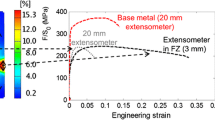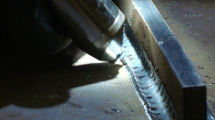Abstract
A recently developed short beam experimental technique has been applied to the characterization of the mode I dynamic fracture toughness (KId) of a commercial tungsten base heavy alloy (w/o-90W-7Ni-3Fe). The specimens were taken from a cylindrical swaged alloy bar and tested at a typical loading rate of the order of 106 MPa\sqrtm/s. Three different crack orientations (one longitudinal and two radial) were investigated. The KIdvalues obtained for the three crack orientations are compared with the corresponding values obtained under quasi-static loading conditions (KIc). Our results show that the dynamic fracture of heavy alloys is both anisotropic and rate sensitive. For specimens containing radial cracks (LR, RR), the dynamic fracture toughness is higherthat its static counterpart. By contrast, for longitudinal cracks (RL), the dynamic fracture toughness is lowerthan the static one. Also, for radial cracks, both the (average) static and the dynamic fracture toughness are higher than in the longitudinal orientation. These new results about the anisotropy of the dynamic fracture toughness of the heavy alloys are reported and correlated with metallographic and fractographic examinations.
Similar content being viewed by others
References
Anderson, C.E., O'Donoghue, P.E., Bodner, S.R. (1988). Fracture of cubical tungsten specimens under explosive loading.International Journal of Impact Engineering 000,371–377.
ASTM (1993). Standard test method for plane-strain fracture toughness of metallic materials.Annual Book of ASTM Standards, Vol. 03.01.ASTM. Philadelphia, PA.
Broberg, K.B. (1999). Cracks and Fracture,Academic Press, NY, USA.
Couque, H., Lankford, J. and Bose, A. (1992). Tensile fracture and shear localization under high loading rate in tungsten alloys.J. Phys. France 22225–2238.
Churn, K.S. and German, R.M. (1984). Fracture behavior of W-Ni-Fe alloys.Met. Trans. 15A, 331–338.
Gurwell, W.E., Nelson, R.G., Dudder, G.B and Davis, N.C. (1984). Fabrication and Properties of Tungsten Heavy Metal Alloys Containing 30% to 90% Tungsten, US DOE Report DE-AC06-76RL0 1830.S
Hack, J.E. (1991). Fracture Behavior of W based Materials.Los Alamos National Laboratory Report9-X68-9104V.
Kalthoff, J.F., Winkler, S., Böhme, W. and Klemm, W. (1980), Determination of the dynamic fracture toughness KId in impact tests by means of impact response curves.Advances in Fracture Research, (Edited by D. François et al.) Pergamon Press, New York,363–373.
Kanninen, M.F. and Popelar, C.H. (1985). Advanced Fracture Mechanics.Oxford University Press. Oxford, U.K.
Kim, D.S., Nemat-Nasser, S., Isaacs, J.B. and Lischer, D. (1998). Adiabetic shearband in WHA in high strain-rate compression.Mechanics of Materials 28,227–236.
Krock, R.H. and Shepard, L.A. (1963). Mechanical behavior of the two phase composite, Tungsten-Nickel-Iron.Transactions AIME 277, 1127–1134.
Nye, J.F. (1957). Physical Properties of Crystals.Oxford University Press, Oxford, U.K.
Ostolaza Zamora, K.M., Gil Sevillano, J. and Fuentes Perez, K. (1992). Fracture toughness of W heavy metal alloys.Materials Science and Engineering A157,151–160.
Ramesh, K.T. and Coates, R.S. (1992). Microstructural influences on the dynamic response of tungsten heavy alloys.Met. Trans. 23A,2625–2630.
Rittel, D. and Roman, I. (1986). Ductility and precipitation in sintered tungsten alloys.Materials Science and Engineering A82,93–99.
Rittel, D. and Maigre, H. (1996). An investigation of dynamic crack initiation in PMMA.Mechanics of Materials 26,229–239.
Wada, H. (1992). Determination of dynamic fracture toughness for PMMA.Eng. Fract. Mech. 41, 821–831.
Weisbrod, G. and Rittel, D. (2000). A method for dynamic fracture toughness determination using short beams.International Journal of Fracture 104,89–103.
Woodward, R.L., Baldwin, N.J., Burch, I. and Baxter B.J. (1985). Effect of strain rate on the flow stress of three liquid phase sintered tungsten alloys.Met. Trans. 16A,2031–2037.
Zurek, A.K. and Gray, G.T. (1991). Dynamic strength and strain rate effects on fracture behavior of tungsten and tungsten alloys. Colloque C3 J. de Physique III 1,631–637.
Author information
Authors and Affiliations
Rights and permissions
About this article
Cite this article
Rittel, D., Weisbrod, G. Dynamic fracture of tungsten base heavy alloys. International Journal of Fracture 112, 87–98 (2001). https://doi.org/10.1023/A:1013581609836
Issue Date:
DOI: https://doi.org/10.1023/A:1013581609836




